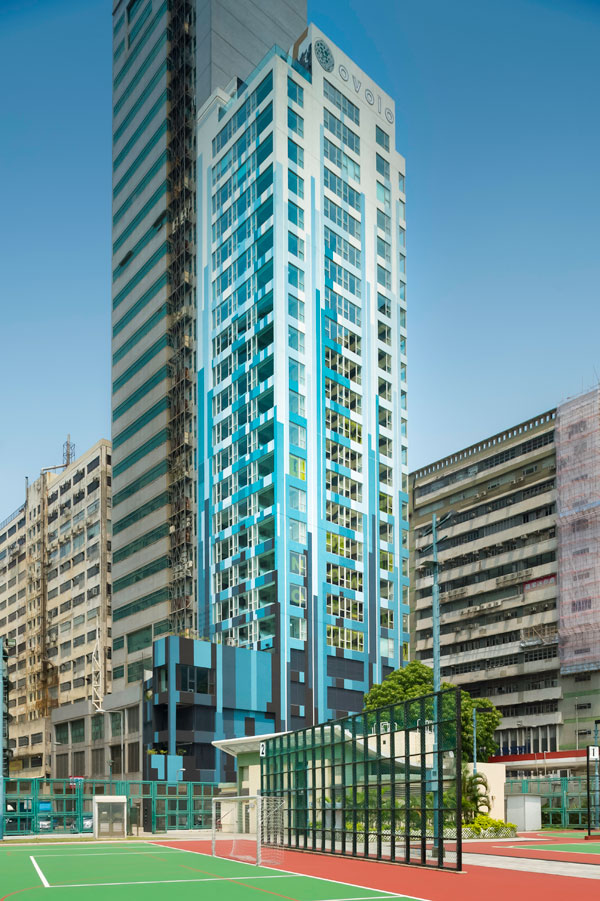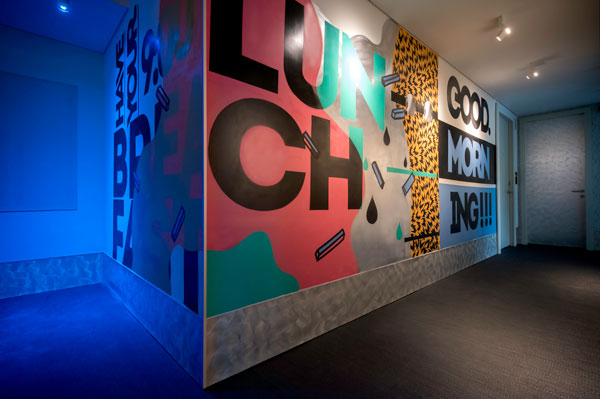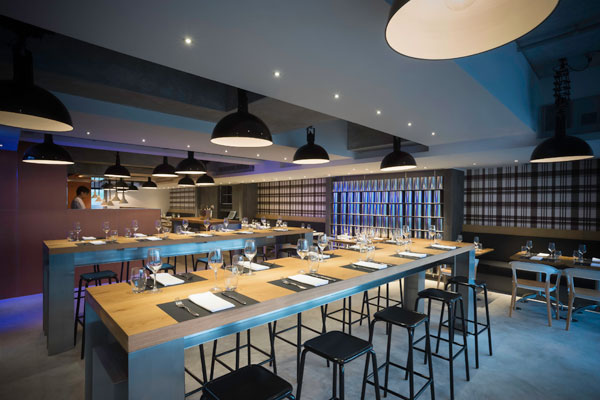Ovolo Southside is the first warehouse turned hotel in Hong Kong, reports JJ.Acuna.

April 15th, 2015
Images: Courtesy of Ovolo Southside
In the outskirts of Hong Kong’s Central hub, about a 15 to 30 minute drive depending on which route you take and at what time of day, lies the Wong Chuk Hang Industrial District, one of several sleepy suburban industrial neighborhoods. Here, a burgeoning fashion, art, and gallery scene is setting a presence in the city, at least for now. Coupled with this resurgence, expectedly, is the rise of property prices for this gentrifying district, especially as a new local MTR station is set to open here within the next year as well as the construction of several new towers by local developers.
For existing buildings, this trend towards the re-development and adaptive re-use of industrial areas in Hong Kong is partly guided by the desire of artists and gallerists for more space. On the other hand, it runs parallel with local government initiatives to re-zone obsolete industrial districts like Wong Chuk Hang to support the city’s tourism sector.

A recently anointed exemplifier of this neighborhood’s renaissance is the unveiling of the new 162 key “loft-style” boutique hotel right in the centre of it called the Ovolo Southside, in October. The first of its kind within Hong Kong Island, the hotel is a prime example of local developers working with key government support, pushing for a successful re-zoning of industrial buildings and adding to the city’s total room offering.
As early as the mid 2000’s, Ovolo’s founder, Girish Jhunjhnuwala, already anticipated these kinds of government zoning initiatives, and purchased the hotel’s industrial property even before the neighbourhood received its current hipster status.
To help make his dream a reality, Jhunjhnuwala employed the assistance of long time collaborators, Hong-Kong-based, KplusK, one of the city’s top boutique architecture and interior design firms. Having already completed three Ovolo properties locally, KplusK created a hotel that fully embraces the neighbourhood’s gritty past and art loving community this time round. With a design and branding concept that is unique to Wong Chuk Hang, KplusK focused on “innovation, creativity, and breaking boundaries”.

“Being located in a one of the few remaining industrial areas in Hong Kong was fundamental inspiration for the design,” says designer, Casey Burgess, who worked on the project directly within KplusK. “Having the opportunity to revitalise a building in Hong Kong, rather than knock it down, was an exciting and ambitious challenge. The result is a juxtaposition of old and new, utilitarian and refined. And art installations can be found throughout – another connection to Wong Chuk Hang’s burgeoning artist community.”
Fair-faced concrete finishes, neon-colored light fixtures in the circulation areas, open ceilings, and exposed masonry define most of the hotel’s unique spaces. In key areas, original site-specific artwork is on prominent display, curated by both Jhunjhnuwala and the designers. Most notable is the 25m-long video wall on the ground floor’s flexible event space, dubbed G.I.G, where Ovolo’s 3D motion video by Brooklyn artist, Jason Tschantré is the main backdrop.
Another shining work is a recently installed silver statue of a man welded in Iron Chain links, titled Anguish 10 by South Korean artist Seo Young-Deok standing at the entry to the reception lobby, greeting guests. Other art works in the hotel include collage pieces in rooms by China’s Zhenggang Xiong and Hong Kong based graphic artist Antoni D’Esterre. The hotel is also big on murals, with each floor sporting super-graphics by Parent’s Parents, a Hong-Kong-based arts collective, and a gigantic yellow and black outdoor mural on the top floor bar, Above, by LA-based duo, Cyrcle.
The decision to leave almost all of the ceilings in the building exposed was a practical choice, which also served the project’s overall industrial character and a hotel’s standard headroom clearance.
“One of the bigger challenges was running services around the building’s massive industrial structure. Some of the beams were a metre in width and depth,” says Burgess of these technical challenges, “To maintain as much ceiling height as possible, the structure was left exposed which required meticulous coordination of building services creating a raw, industrial feel while keeping it aligned and clean.”
The finished effect is sublime. In each room exposed surfaces were clad in a “concrete texture finishing”, and M&E pipes carefully wrapped in silver aluminum foil, or painted in colours like grey and lime green to differentiate the use of each pipeline. Additionally, Burgess says that the “development of a project without precedence in Hong Kong met its own unique challenges. Being the first warehouse-hotel conversion meant the authorities didn’t always know how to respond when it came to implementing building regulations.”
For Ovolo Southside and its team of collaborators, the final product is certainly a benchmark for future developers as more buildings are retrofitted for re-use. The globally recognised Design Hotels collection has recently added the property as its third in Hong Kong due its unique response to the building’s retrofit and surrounding context.

The Cirqle restaurant, with its modern-Mediterranean themed dishes, is already proving a destination draw for the city’s foodies while the views at Above bar over Wong Chuk Hang’s industrial landscape and the green mountains beyond are rare for a city used to seeing only towers.
“I recall my first site visit to the building and being surprised and excited by the young, fashionable crowd,” adds Burgess, “The area has an exciting energy and potential. I hope future projects will respect surroundings in a similar way, and preserve buildings rather than knock them down.”
This article first appeared in Cubes Indesign issue 71.
KplusK
kplusk.net
A searchable and comprehensive guide for specifying leading products and their suppliers
Keep up to date with the latest and greatest from our industry BFF's!

Channelling the enchanting ambience of the Caffè Greco in Rome, Budapest’s historic Gerbeaud, and Grossi Florentino in Melbourne, Ross Didier’s new collection evokes the designer’s affinity for café experience, while delivering refined seating for contemporary hospitality interiors.

The Sub-Zero Wolf showrooms in Sydney and Melbourne provide a creative experience unlike any other. Now showcasing all-new product ranges, the showrooms present a unique perspective on the future of kitchens, homes and lifestyles.

Create a configuration to suit your needs with this curved collection.

In the pursuit of an uplifting synergy between the inner world and the surrounding environment, internationally acclaimed Interior Architect and Designer Lorena Gaxiola transform the vibration of the auspicious number ‘8’ into mesmerising artistry alongside the Feltex design team, brought to you by GH Commercial.
The internet never sleeps! Here's the stuff you might have missed

A third in the series of boutique hotels under the Lloyd’s Inn brand, Lloyd’s Inn Kuala Lumpur bring the immediacy of nature to the new high-rise hospitality experience in the heart of a bustling city. “Lloyd’s Inn Kuala Lumpur is unique from the other properties in that it is a high-rise development, with more than […]

London-based Carmody Groarke and Paris-based TVK have been announced as winners of a milestone competition for the new Bibliothèque nationale de France conservation centre.